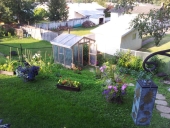Jen, you might have a patch of dirt that is infected with a soil fungus like
fusarium. It can stay in the ground for years, attacking whatever you plant, until you plant something that is strong enough to kill it. Tell me, was there a lot of garlic mustard growing in that area? Because mustard is one of the few things that can compete with fusarium, and in large quantities can kill it off.
I'm pretty sure my property was infected with Fusarium when I bought it. It took an eggplant seedling all of three days to croak when I tried it the first season. But as we say in permaculture, "the problem is the solution", and to get rid of your fusarium, you're going to need to plant it with mustard and then turn that under in the fall. The sulfur compounds in the mustard, which are responsible for its sharp flavor, are what can kill off the fusarium fungus. Since I seeded my whole garden to mustard and disked it under, I have had minimal problems with it. It hasn't gone away completely, but I have it definitely under control. If I see it starting to reappear, I get the mustard seed and sprinkle it around for a spot treatment. I lost some beans and tomatoes in a new bed I put in the side yard, and so it's now been seeded with mustard for a treatment.
While the roots of the mustard plants will knock back the fusarium some, and it makes a good companion plant to keep other plants from being attacked, you really need to disk the tops under to get the full effect. If you want to give your juniper and forsythia a fighting chance, get a bag of mustard greens from the grocery store, blend them up with some water, and use that as a root drench.









